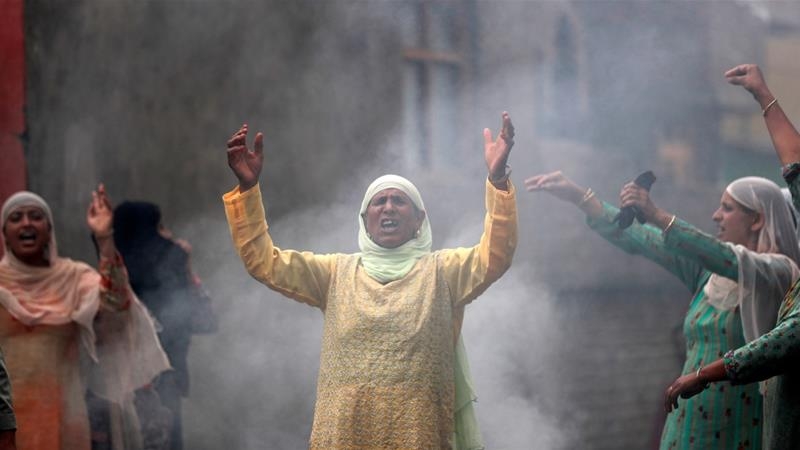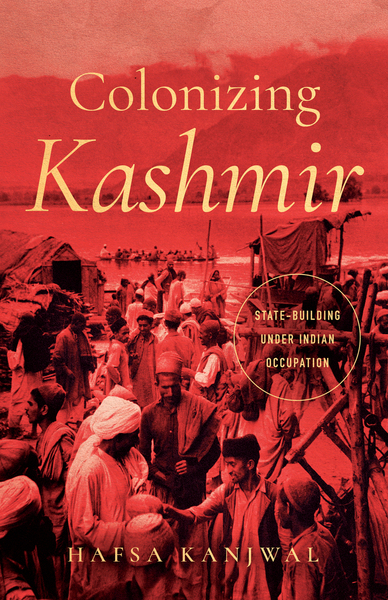
Book excerpt – Colonizing Kashmir: State-building Under Indian Occupation
In Colonizing Kashmir: State-building Under Indian Occupation (Stanford University Press, 2023) Hafsa Kanjwal examines how the Indian and Kashmir governments utilized state-building to entrench India’s colonial occupation of Kashmir in the aftermath of Partition. Colonizing Kashmir historicizes India’s occupation of Kashmir through processes of emotional integration, development, normalization, and empowerment to highlight the new hierarchies of power and domination that emerged in the aftermath of decolonization.
Excerpted from Colonizing Kashmir: State-building under Indian Occupation by Hafsa Kanjal, published by Stanford University Press, ©2023 by Hafsa Kanjwal. All Rights Reserved.
Footnotes have been removed for readability.
Hafsa Kanjwal is an assistant professor of South Asian History in the Department of History at Lafayette College in Easton, Pennsylvania, where she teaches courses on the history of the modern world, South Asian history, and Islam in the Modern World.

Driven by the belief that any form of political activism calling for a resolution of the Kashmir issue or a plebiscite was a threat to the “security of the state,” the Kashmir government developed a series of legal and extralegal practices of surveillance and control. An enduring state of emergency belied what was otherwise being promoted as a democratic order. This indefinite state of emergency was an exercise in colonial control, aimed at suppressing people’s political aspirations as well as their agency by marking all dissent as being sponsored by Pakistan. Meanwhile, political dissidents were constrained not only by the repression meted out by the Kashmir government but also the ambiguities inherent in their leadership’s demand for self-determination in the context of the UN resolutions and shifting political developments. In addition to a lack of ideological coherence amongst dissidents, one of the primary reasons why the dissident groups were unable to sustain a strong political opposition is that many of the leaders were operating within the same frame of reference and background as those who were officially in power.
[…]
Given the restrictions on archival research on Kashmir at the National Archives of India, it is difficult to ascertain to what extent and in what way the Government of India was directly involved in managing dissent at this time. What we can gather is that the Indian government had its own intelligence agencies spying on the broader society along with the Kashmir leadership as well as armed police check posts in the region to “tackle large-scale attempt[s] at infiltration, subversion, sabotage, and political conspiracy.”
Much of the Indian government’s attention was on the border with Pakistan to ward off any attacks, while the Kashmir government focused more on managing dissent internally and producing a “compliant, unthreatening population.” Indian officials were primarily concerned with border raids, illicit trade, and people moving across the cease-fire line. They would keep a close eye on those Kashmiris, in particular, who were attempting to come back from Pakistan after Partition and the first India-Pakistan war and settle once more in Kashmir. These individuals—ostensibly refugees now marked as infiltrators—required approval from the local district magistrate granted only when it was ascertained they were not involved in any pro-Pakistan politics and were of “good character.” In the police and intelligence files, characterizations of “good character” were not deployed simply for citizenship or resettlement but also for more mundane matters among regular residents such as starting a new newspaper or seeking permits or licenses, signifying the penetrating reach of the surveillance grid into all levels of society and forcing people to retreat from political activity.
[…]
In addition to the numerous surveillance, intelligence, and armed agencies, a series of heavy-handed laws criminalized political dissent. As Duschinski and Bhan argue, if we take into account the role of law in playing a “formative and constitutive role in relation to the social, cultural and political dynamics of occupation,” then the series of draconian laws were meant to assert colonial control and “institute a state of emergency and permanent crisis in Kashmir,” a dynamic that was fundamental to the logics of occupation. Although international law has yet to legally recognize Kashmir as an occupation— it is critical to understand how “occupation was ‘produced in and through’ a complex set of legal processes by which a permanent state of emergency [was] established.” And while these measures are “always portrayed as being ‘temporary’ or ‘provisional’ until the security situation [is] brought [under] control,” they in effect create a sense of permanent danger and instability. This, then, creates a situation where state sovereignty is established primarily through the ongoing criminalization of all forms of dissent.
A number of draconian laws, including the Public Security Act, were remnants from the Dogra period. However, the level and extent of suppression during the Bakshi period surpassed that of the Dogras. During the later part of Dogra rule, various political parties, including the National Conference, the Muslim Conference, the Kisan Mazdoor Conference, and the Kashmir Socialist Party, could hold public meetings and annual conferences. Members of these parties even contested in and won elections. There was more restriction on the press under Bakshi than under the Dogras; the latter allowed opposition parties to publish papers whereas the former censored them. Kashmiris living outside the region, even in India, had more freedom to publish papers of varying perspectives than their counterparts in Kashmir.
In 1954, the Supreme Court of India extended its jurisdiction to Kashmir as a means of further integration. That meant that the fundamental rights of citizens guaranteed by India’s constitution applied in the region; however, as Sumantra Bose argues, “These civil liberties could be suspended at any time at the discretion of [Kashmiri] authorities in the interest of ‘security,’ and no judicial reviews of the suspensions would be allowed. In effect, this was carte blanche for the operation of a draconian police state in [Kashmir].” A wide range of laws contributed to the permanent state of emergency. The Public Security Act curtailed civil liberties and allowed for the confiscation and requisition of any property. The Enemy Agents Ordinance, introduced by Bakshi in 1948, allowed arrest and trial of those suspected of pro-Pakistan leanings, resulting in punishment ranging from imprisonment of ten years to the death penalty. Individuals faced trial in a “designated special court with no right of appeal for persons designated as enemy agents or as persons aiding the enemy.” The ordinance applied to those peacefully calling for a plebiscite. Public meetings and processions, unless in support of the ruling party, were forbidden under Article 50 of the Defense of India Rules. The Ingress and Egress Act pushed back to the other side of the cease-fire line any undesirable resident of the state. Various regulations under the Defense of India Rules were also promulgated during the Indochina War of 1962; a number of Kashmiri leaders, including Sheikh Abdullah, were held without trial under these rules. In addition, some government-affiliated individuals lost their jobs for speaking out against the state.
[…]
For all other cases of preventive detention, there were ambiguities surrounding the purposes of detention—whether they were done in the interest of public safety or peace, maintenance of public order, or security of the state. Security of the state was a more serious crime and entailed protection of the country from foreign aggression (including attempts to overthrow the government, rebellion, or war) while public order involved ordinary breaches of public safety such as protests, riots, or communal incidents but not danger to the state itself. Indian officials encouraged the use of security-of-the-state charges to detain most pro-plebiscite or pro-Pakistan political dissidents, even if their activities did not fall under the purview of the clause. V. Narayanan of the Indian Ministry of States even admitted that “when the grounds for detention… are furnished, it is possible that some of them might be viewed as relatable more to the ‘maintenance of public order’ than the ‘security of the state.’” For some of the detainees—including Abdullah—the evidence wasin the speeches they delivered, seeking to “inflame communal passions and break up the integrity of the state.” Yet, in other cases, there were no specific speeches or actions and thus no definite grounds for detention. Rather, these individuals were said to be “members of a particular group whose object was to do certain things.”
Hafsa Kanjwal, Colonizing Kashmir: State-building Under Indian Occupation. Stanford University Press, 2023.
